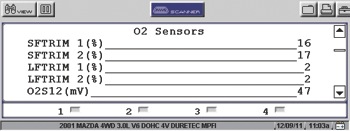#173;values of less than 80% are indicative of a calibration problem with the MAF sensor or of a restriction in the engine’s fuel, air intake or exhaust system. See Photo 4.
Some applications also use the MAF, TP and engine speed inputs to estimate barometric pressure (BARO). The BARO value might be expressed as a frequency (Hz) or as inches of mercury (“Hg). In any case, if the recorded barometric pressure isn’t equal to local barometric pressure, it’s indicative of a calibration problem with the MAF sensor or a restriction in the engine’s intake or exhaust system.
BASIC FUEL TRIM ANALYSIS
Engineers program a “fuel map” into the PCM that indicates the exact amount of fuel required to meet hundreds of different operating conditions. Since this fuel map is monitored by the oxygen or air/fuel ratio (AFR) sensors, fuel might need to be added or subtracted to bring the oxygen or AFR sensors back to “center” or to a chemically correct stoichiometric value. More fuel being added to the programmed fuel map value results in a positive “fuel trim” number, while subtracted fuel results in a negative fuel trim number.
Most MAF calibration problems are indicated by the classic P0171 and P0174 DTCs. Fuel trim analysis can be tricky because intake manifold vacuum leaks and insufficient fuel supply can also set these DTCs. Negative fuel trim numbers caused by minor intake vacuum leaks generally disappear under heavy engine loads. Positive fuel trims caused by leaking fuel pressure regulators and injectors also tend to disappear under increased engine loads.
Short-term fuel trims reflect the immediate demands of the engine, while long-term fuel trims are an average of short-term fuel trims. Fuel trims of plus or minus 10% are considered normal, while plus or minus 25% will generally set an appropriate DTC. See Photo 5.
But negative fuel trims at higher engine loads can also be caused by dirty MAF sensors or by low fuel pressures. Consequently, it’s important to eliminate fuel delivery issues by testing fuel pump pressures and volumes before assuming that the MAF sensor is truly defective. In most cases, a defective MAF sensor will reveal itself through a combination of the evaluation techniques mentioned above.
Last, it’s important to understand that the metal film resistors generally lose their calibration due to normal wear and tear. While a careful cleaning might restore a MAF sensor’s basic calibration, that level of calibration might not pass one of the many different exhaust emissions tests enforced throughout the U.S. So, if you’re in doubt, it’s best to always replace a MAF sensor suffering from a suspected calibration defect.
Sidebar:
Why Do MAF Sensors Fail?
Contamination is a key reason why MAF sensors fail and require replacement. As air, dirt and other debris get into the sensor, the parts become contaminated and fail. Drivers often notice sluggish performance, rough idling, poor acceleration or even stalling. There may also be a more frequent need to refuel.
Contamination could even occur as early as at every 18,000-25,000 miles, depending on the vehicle model. For example, with small or compact cars, the MAF sensor can clog quicker, as it is placed in a smaller engine bay subjected to more risk in critical areas (oil vapor flows and combustion debris). In this case, a replacement becomes the equivalent of a long drain oil service…it almost becomes a service-style repair.
Other common failure problems include:
• Contact fault at the electrical connections;
• Damaged measuring elements;
• Mechanical damage (vibrations, accident); and
• Measuring element drift (exceeding the measuring framework).
A problem with the mass air flow sensor often causes the ”check engine” or ”service engine soon” light in the vehicle instrument panel to illuminate. These lights come on when the engine computer detects some fault in one of the components of the emission control system.
Symptoms of failure include:
• “Check engine” or “service engine soon” light is on;
• Hesitation/stall on rapid acceleration;
• Poor engine running at idle and/or surge;
• Excessive vibrations when stationary; and/or
• RPMs changing noticeably without driver input.
How to troubleshoot a MAF sensor:
The following steps should be taken into account during MAF sensor troubleshooting:
• Check the connector for a correct fit and good contact.
• Check the MAF sensor for damage.
• Check the measuring elements for damage.
• Check the voltage supply with the ignition switched on (circuit diagram for pin assignment is necessary). Ref. value: 7.5-14V
• Check the output voltage with the engine running (circuit diagram for pin assignment is necessary). Ref. value: 0-5V
• Check the connection cables between the removed control unit connector and sensor connector for transmission (circuit diagram for pin assignment necessary). Ref. value: approx. 0 ohm.
• Conduct an electronic test of the MAF sensor by the engine management control unit. If a fault occurs, a fault code is stored in the control unit and can be obtained using a diagnostics unit.
Courtesy of Delphi Product and Service Solutions.








